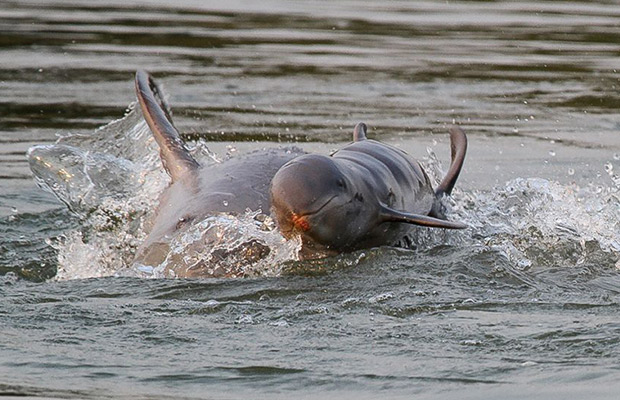
- Travel Name: Irrawaddy Dolphins, Kratie
- Travel Destination: Kratie
Fewer than 100 of the lovely Irrawaddy dolphins are now thought to inhabit a 190-kilometre stretch of the Mekong, running between Kampi, just north of Kratie, all the way up to Laos. Around 25 of these live off of Kampi, an attractive village extending along the river. Considered sacred by Khmer and Lao people, they are also a valuable source of income for communities along the Mekong. But the relationship is far from usually mutually beneficial.
Irrawaddy Dolphins about fifteen to twenty of these rare freshwater dolphins make their home on a beautiful stretch of the Mekong River near a small set of rapids. They make upward arches, breaking the surface of the water as they swim about the area. They are not jumpers like their sea-faring relatives and are quite a bit shyer as well. They have good reason to be shy towards humans as they have been hunted and killed by fishermen in the past. The hope is that their numbers will slowly increase, as more fishermen in the area are educated about them. They are most active in the early morning hours (around 6 am) and the late afternoon and early evening hours.
However, we went during the mid-afternoon heat of the day and had numerous sightings. A local family hires out their small towboat and a son to take you out on the river for a closer look. The charge is 3,500 riel per person. To get there, just follow the road north from the Globe traffic circle for 14 km Turn left at the dolphin picture sign. The family and river are there.The Mekong River Irrawaddy dolphin (Orcaella brevirostris) population inhabits a 190km stretch of the Mekong River between Cambodia and Lao PDR. The latest population is estimated between 64 and 76 members (2008 figures). The Irrawaddy dolphin is identified by a bulging forehead, a short beak, and 12-19 teeth on each side of each jaw. The pectoral fin is broadly triangular. There is a small dorsal fin, on the posterior end of the back.
Many dolphins drown after getting caught in fishing gear — specific types of which have now been banned and are monitored with patrols up and down the river — and pollution is a continuing threat, as toxic chemicals, including DDT, PCB and mercury from mining upriver, have reportedly laid waste to their immune systems. Illegal fishing, however, remains an issue, including blast fishing where fishermen use explosives that kill everything within the blast radius. Meanwhile, plans for yet another dam further up the Mekong, in Laos, have also raised concerns about the use of explosives to blast out the rock to create the dam. Some fear that the sound waves will finally kill off what remains of the entire population.
In 2009, the World Wildlife Fund produced a damning report on the pollution levels in the Mekong, and the impact they were having on the vulnerable population, including the deaths of 88 dolphins between 2003 and 2009. The report provoked a furious response from the government, which denied that pollution was an issue.

Copyright © 2025, Cambo Tours & Travel - Discover Authentic Travel Experience, All Rights Reserved.